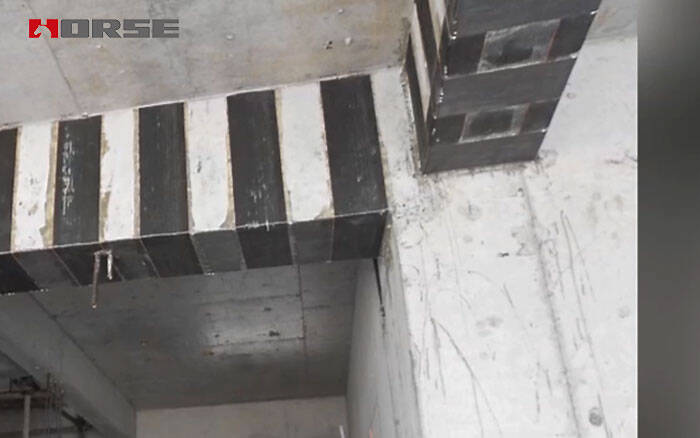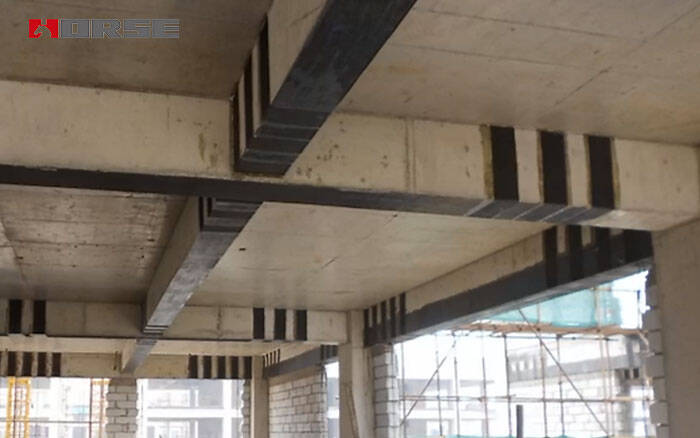Carbon fiber fabric for seismic strengthening
structural cracks
In order to ensure the safety of the building structure, it was decided to demolish the commercial staircase for redesign and construction. At the same time, the damaged members were repaired and strengthened by CFRP(carbon fiber fabric).

The prevention of earthquake disaster should be to adopt reasonable structural seismic design methods, improve the seismic capacity of buildings, to avoid serious structural damage and collapse. However, earthquake disasters will inevitably cause damage to houses, but only to varying degrees. The May 12 earthquake affected our small county town, causing varying degrees of damage to most of our houses; and the continued aftershocks have brought more serious consequences to these damaged buildings. In order to avoid more serious damage and building collapse, it is more important to strengthen and repair damaged houses after identification. Therefore, repair of earthquake damage to housing structure is an important task for the disaster area to resume construction.
1. The causes of concrete cracks and some main treatment methods in various concrete projects, cracks are inevitable, micro-cracks are determined by the physical and mechanical properties of concrete itself. At present, the restrictions on cracks in different countries are not exactly the same, but they are almost the same. The most stringent allowable crack width is 0.1mm. When cracks occur, the causes of cracks should be analyzed and properly treated to meet the requirements of structural safety, quality acceptance and service function.
2. Case study of earthquake damage Engineering
After the May 12 Earthquake, we found that the damaged commercial apartment buildings (12-storey frame structures) in the downtown area had the hidden danger of structural damage. Considering the safety of the first or second storeys of Commerce and the upper residence, we must ask professional organizations to test and appraise, and then repair and strengthen.
The project was built in November 2002 (completed in October 2001) with a floor area of 20,000 square meters, a total of 12 floors, 4.5m on the first floor, 3.6m on the second floor and 3.0m on the other floors. The main structure is a cast-in-situ reinforced concrete frame, the structural slab is C25, the first two storeys of beam and column concrete are C40, 3 ~ 12 storeys of C30 concrete, filled with retaining wall. The project was completed and put into operation two years later. It was the first comprehensive residential building in the town, which integrated commerce and housing.
May 27, 2008 by the provincial Academy of Architectural Sciences Inspection Center inspection and identification of the building damage level is slight damage (the first floor of the commercial ladder between moderate damage). Under the influence of earthquake aftershocks, the building suffered new seismic damage: the roof of the first floor (podium garden) partially cracked, seepage occurred. The following month, the testing center of the Academy of Architectural Sciences carried out a comprehensive test again. The evaluation conclusion: In the ultrasonic testing depth test, no dangerous components were found in the attached building, but the crack depth of the local components of the main building and commercial floor exceeded the standard. Detailed ultrasonic testing records were recorded. There are dangerous components in the testing area. The damage degree of the two stairs in the East and west of the commercial floor has affected the safety and normal use of the structure and needs to be dismantled and redesigned.
After repeated discussions between the owner unit and the original design unit, in order to ensure the safety of the building structure, it was decided to demolish the commercial staircase for redesign and construction. At the same time, the damaged members were repaired and strengthened by CFRP(carbon fiber fabric).
3. CFRP reinforcement technology in earthquake damage Engineering
3.1 materials and tools selection
Carbon fiber cloth and its supporting structure bonding, construction tools selection angle grinder, hair dryer, scissors, rolling brush, scraper and so on.
3.2 construction technology
Construction preparation, removal of load on the beam and slab structure, component surface treatment, coating primer, brush bond, paste carbon fiber cloth, brush bond, static solidification, hidden acceptance, plastering protection.
3.2.1 construction preparation
(1) According to the sound wave detection record and the designer jointly determine the specific location and number of the strengthened members.
(2) Carefully read the inspection and evaluation report of the testing center of the Provincial Academy of Architectural Sciences and the reinforcement design and construction drawings issued by the design unit and examined and approved by the structural drawing examination organization.
(3) detailed construction plan is drawn up according to the actual situation of the reinforced component.
3.2.2 surface treatment of concrete components
Remove the surface part of the component (plastering layer) and grind it to expose cracks in the concrete compact layer. Use epoxy mortar for grouting treatment, and then use epoxy mortar to smooth the surface. The concrete of the sticking part is polished evenly, and the dust on the surface is thoroughly removed and kept dry by high-pressure air blowing with air pump.

3.2.3 steps and requirements for sticking carbon fiber cloth
(1) the minimum width of carbon fiber sheet should not be less than 100mm after cutting according to the required size.
(2) Use special cleaning brush sticking parts, cool and dry, the bonding adhesive evenly applied to the need to stick parts of the concrete surface;
(3) Carbon fiber cloth is applied on the base layer coated with bonding adhesive, and the bonding adhesive is fully immersed in the carbon fiber bundles by scraper along the fiber direction for many times, and the bonding adhesive is made smooth without bubbles;
(4) Repeat the above steps when pasting two layers of carbon fiber cloth. After the surface of carbon fiber cloth is dried with finger touch, the next layer is pasted immediately, and a adhesive is evenly applied on the surface of the last layer of carbon fiber cloth.
4. Acceptance and late protection
After CFRP is pasted, maintain for 7 days. After the design and testing unit is qualified, the carbon fiber of the reinforcement area is coated with epoxy adhesive. A layer of dry coarse sand is sprinkled on it, and then mortar is added to protect it.
During the curing period, the members are not affected by dampness, fire and extrusion, and no load and vibration can be added to the components.